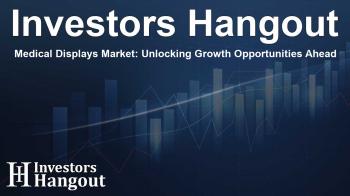Medical Displays Market: Unlocking Growth Opportunities Ahead

Medical Displays Market Overview
The global medical displays market is on an impressive growth trajectory, with a projected valuation estimated to reach US$3.45 billion. This noteworthy surge from US$2.50 billion, which marked the market's value in 2024, is attributed to several key factors. The ongoing rise in chronic diseases, coupled with an aging population and advancements in high-resolution diagnostic imaging, is reshaping the landscape of healthcare delivery.
Drivers of Market Growth
Rising Healthcare Needs
As healthcare infrastructure continues to modernize, medical displays are evolving into integral assets rather than simple viewing devices. The demand for precise imaging and data visualization is critical in today’s healthcare environment, where timely decision-making can significantly influence patient outcomes. The robust growth of this market is a direct response to these evolving healthcare demands.
Emerging Technology Integration
With the advent of advanced imaging technologies, medical displays are at the forefront of diagnostic excellence. They enable healthcare professionals to view multiple imaging modalities, such as MRI, ultrasound, and fluoroscopy, all on a single screen. This capability fosters collaboration and enhances surgical precision, addressing clinical needs effectively.
Applications and Benefits
Clinical Applications
Medical displays cater to various medical disciplines including radiology and telemedicine. They boast applications in hybrid operating rooms (ORs) where real-time imaging is crucial for successful interventions. The integration of color displays, known for their soft tissue contrast capabilities, further reinforces their importance in detecting chronic conditions and aiding in surgical preparations.
Operational Advantages
Enhanced workflow efficiency is a significant benefit of modern medical displays. With the ability to visualize real-time patient data, healthcare providers can reduce errors and improve patient care delivery. Collaborative environments fostered by these displays allow for seamless communication among medical professionals, ultimately leading to better outcomes.
Market Trends
Focus on Emerging Markets
Regions such as India, Brazil, and Southeast Asia are witnessing a rapid transformation in their healthcare infrastructure. Government initiatives and increased capital access significantly boost the demand for advanced medical display technologies. This presents a wealth of opportunities for imaging Original Equipment Manufacturers (OEMs) and healthcare providers.
Leaders in the Field
Several companies are positioned to lead in this burgeoning market. Key players like Barco, EIZO, and Sony are expanding their offerings with advanced 4K and 8K displays, specifically designed for medical applications. These innovations not only meet current market demands but also pave the way for future advancements in medical imaging.
Challenges and Solutions
Barriers to Adoption
Despite the potential of the medical displays market, there are inherent challenges that can hinder growth. The high initial costs associated with state-of-the-art displays and the prevalence of refurbished systems in some regions can pose significant barriers. To navigate these obstacles, stakeholders must focus on healthcare outcomes and ROI justifications.
Strategies for Unlocking Growth
Adopting frameworks that emphasize return on investment and operational efficiency can play a crucial role in overcoming barriers. Additionally, fostering clinician training and ensuring compliance with certifications can facilitate smoother adoption processes for advanced displays.
Conclusion
The growth trajectory of the medical displays market is not just statistically significant—it represents a fundamental shift in how healthcare is delivered. The integration of innovative displays enhances diagnostic accuracy and fosters an environment where swift, informed decisions can be made. As hospitals and surgical innovators invest in these technologies, they are not merely upgrading equipment; they are investing in the future of patient care.
Frequently Asked Questions
What is the projected value of the medical displays market?
The medical displays market is projected to reach US$3.45 billion by the end of the forecast period.
What are the main drivers of growth in this sector?
Key drivers include the rise in chronic diseases, advances in healthcare technology, and an aging global population.
How do medical displays enhance healthcare delivery?
They improve diagnostic accuracy, streamline workflows, and facilitate better collaboration among healthcare teams.
Which regions are experiencing the most growth?
Emerging markets, particularly in Southeast Asia and South America, are seeing significant advancements in healthcare infrastructure and technology adoption.
Who are the leading companies in the medical displays market?
Leading companies include Barco, EIZO, Sony, and LG, with a focus on developing advanced imaging solutions.
About The Author
Contact Hannah Lewis privately here. Or send an email with ATTN: Hannah Lewis as the subject to contact@investorshangout.com.
About Investors Hangout
Investors Hangout is a leading online stock forum for financial discussion and learning, offering a wide range of free tools and resources. It draws in traders of all levels, who exchange market knowledge, investigate trading tactics, and keep an eye on industry developments in real time. Featuring financial articles, stock message boards, quotes, charts, company profiles, and live news updates. Through cooperative learning and a wealth of informational resources, it helps users from novices creating their first portfolios to experts honing their techniques. Join Investors Hangout today: https://investorshangout.com/
The content of this article is based on factual, publicly available information and does not represent legal, financial, or investment advice. Investors Hangout does not offer financial advice, and the author is not a licensed financial advisor. Consult a qualified advisor before making any financial or investment decisions based on this article. This article should not be considered advice to purchase, sell, or hold any securities or other investments. If any of the material provided here is inaccurate, please contact us for corrections.

